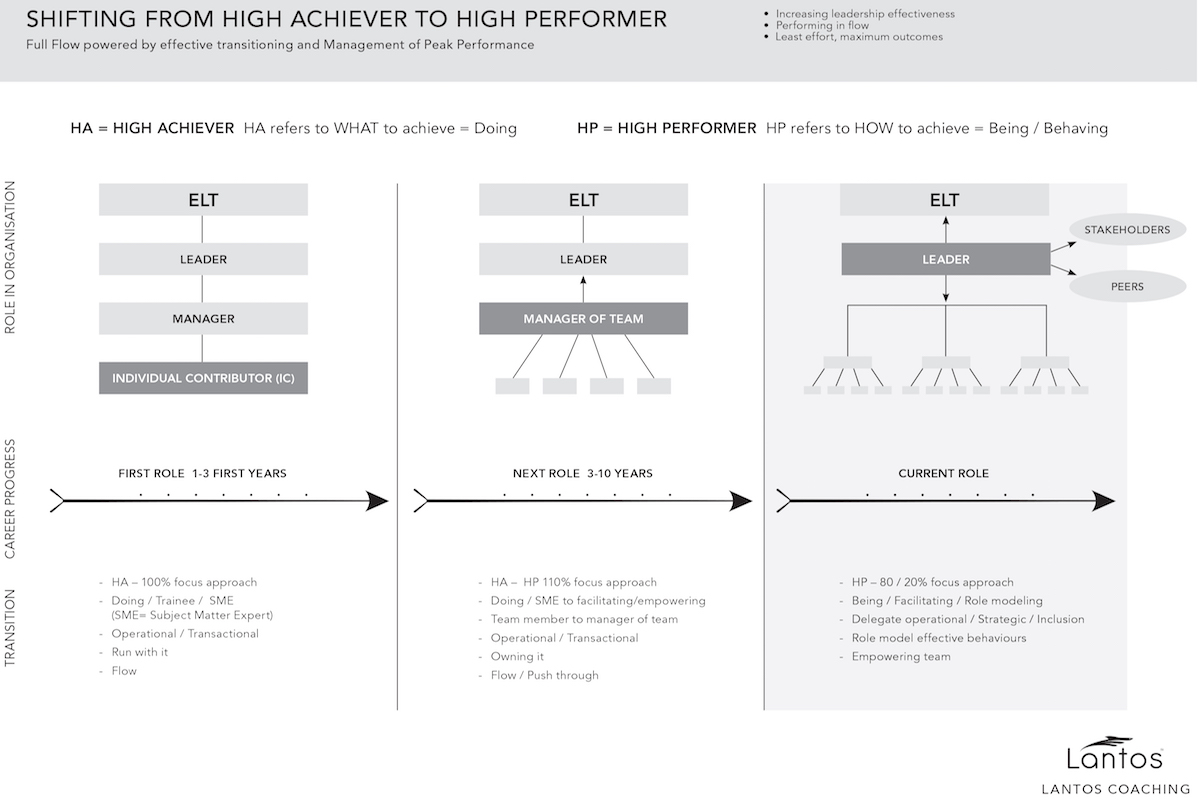Leaders who perform at their peak and spend more time in ‘flow’ have learned a powerful self-awareness strategy: to recognise when they are in high achiever mode and learn how to shift back to high performer mode.
In peak performance, we feel at our best and do our best work. Peak performance is the state where you can best apply your strengths and skills set. You have the right amount of healthy pressure to keep your mind sharp, and lose track of time as you enjoy the process. Creativity and productivity come easily with the least conscious, self-limiting talk.
Why is it important for a leader to know how to shift from high achiever mode to high performer mode? Increased self-awareness is the key to accelerating your journey towards effective and authentic leadership.
In my experience as an Executive Coach, leaders who manage their peak performance work with less effort and achieve better outcomes for themselves and their team because they optimise their decision-making and increase their adaptability and resilience.
Sounds good, doesn’t it? But it takes practice and is particularly hard when you are in a newly acquired leadership role. If you are tired of constantly pushing through adversity and setbacks – to the point of exhaustion – to get things done, you are probably working in high achiever mode.
Of course, we all face adversity. And it will mostly come up when it’s least convenient. But your time and energy is precious. You want to thrive and enjoy the complex and demanding leadership role you have, but you also want to have a life.
So what does this shift involve? Being a high achiever or a high performer are two different points on the leadership effectiveness scale. Shifting between the two states seems simple, yet it’s more complex than some might think. The good news is, with some consistent practice and these three reminders, it will get in your muscle soon, and never look back.
From high achiever to high performer mode
Where are you now?
Shifting from high achiever to high performer mode starts when you recognise that you are pushing through a task or project on your own. High achievers are laser-focused on the task at hand and find it hard to delegate, especially with time constraints. They would rather do the work themselves than delegate. They have high standards and often push through without much anticipation or thinking through, nor will they ask for help or involve others. High performers realise when they need to take a step back, reflect and reset for the most effective outcome.
Prepare your next step
High performers anticipate and prepare before they attend to a task. This gives them better insights as to whom they need to involve or what information or input they might need to get the most effective outcomes. With this approach, they have the benefit of creating buy-in along the way. As they share their train of thought, they achieve a broader and more sustainable outcome. By involving others, they also provide learning and growth and are able to delegate more, creating more headspace for reflection and strategic thinking.
As soon as you recognise you are in high achiever mode, pause. Now plan your next step. Doing so will switch on your high performing mindset.
Stay with the big picture
High performer mode is a more self-aware way of being. Now that you are back into planning ahead (see above), remind yourself that, as a leader, your role is to focus on the bigger picture rather than on specific tasks. Facilitate your teams more. Role model the right behaviours. If the approach you are taking doesn’t work for you anymore, let it go instead of endlessly pushing through, and prepare a different approach.

Once you have taken these steps, ask yourself if you have fully transitioned from individual contributor (high achiever) to manager to leader (high performer) again? Have you moved from doing leadership to being a leader. Or do you still find yourself acting as the subject-matter expert, in high achiever mode. Do you tell yourself you don’t have time to reflect or delegate? Not shifting will come at a cost, as you probably already know.
Perhaps you are thinking that you’ve shifted before, but find yourself back in the high achiever mode again and again. Relax. We can’t be in high performer mode or in peak performance all the time. We transition in and out of these states. Imagine that the next time you realise you’re not at your best – when you notice you are frustrated, bogged down in details and not making the progress that you need – you take a step back, reflect and just reset sooner.
Invest time to:
- Ask your team the right questions
- Encourage them to step up
- Share the bigger picture, your intentions and your train of thought
- Let your team surprise you with the progress they can make when they have more information to think for themselves
You might find you have enjoyed the process more, wasted less energy, empowered your team and created more opportunity for strategic thinking.
Now that you know when and how to shift, I’m excited for you to discover when you recognise the cues, and how you become quicker at doing so. This process is how you will become an effective, adaptable and resilient leader.







